Dave Hunter: Output Tube Types – Setting the Foundation of Your Tone
by Dave Hunter
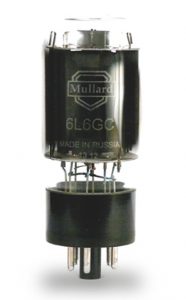
A handful of output tube types have been associated with the sounds of classic amps throughout the decades, and have therefore become part of the aural iconography, if you will, with which we define guitar tone in general. Some amp makers will tell you that a good circuit designer can coax just about any tone out of any type of output tube. Run the racks of classic and boutique amps alike, though, and you’ll discover specific tube types enhancing distinctive sonic characteristics time and again. Leo Fender might have used 6V6s and 6L6s for his tweed Deluxe and Twin Reverb respectively—to name but two examples—because they were available and affordable, but now that those sounds have been canonized we know exactly which tubes to use to get them.
Undoubtedly a talented maker can achieve a wide range of sounds from any tube set, and most can be manipulated to sound fantastic clean or overdriven and anywhere in between. Even so, this article explores what you should expect when you’re looking to dial in the classic sounds of each of these most-used output tubes, as well as pointing out some of the great designs—both vintage and contemporary—in which they are used.
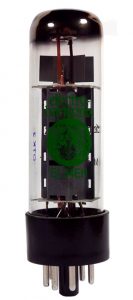
Note that I’m using the term “output tubes” here because these tubes are part of what we call the “output stage” of the amplifier and generate the amp’s output signal which, via an output transformer, pushes the speaker(s). You will also hear the term “power tubes” used for these types, although I generally prefer output tubes to avoid confusion with rectifier tubes, which convert the AC power to the DC voltages that the tubes themselves run on.
If you’re new to the whole tube-spotting thing, it’s usually not too difficult to figure out what you’re looking at in the back of any amp that carries them. In most cases output tubes are the biggest—or at least tallest—tubes in the back of your amp (although a tube rectifier, if your amp has one, can also be mistaken for one of these).
Many different types of output tubes were used in the glory days of these thermionic devices, when they appeared not only in guitar amplifiers, but in radios, stereos, TVs, broadcasting equipment, radar, and many other applications. Today, only about half a dozen varieties of output tubes are used regularly by contemporary amp manufacturers, and just four of these are seen in any great numbers. The four most common output tube types are the 6L6GC (sometimes as the 5881 variation), 6V6GT, EL34, and EL84. A handful of contemporary makers still offer amps with KT66, KT88, and 6550 tubes, and a few even manufacture unusual designs using more esoteric tube types like the 6BM8 (aka ECL82), 7591, and 6973, but you’ll see one of those first four in a good 95% of amps you encounter today.
Among the more common types, EL84s (and lesser-seen 6BM8s and 6973s) are the same diameter as most preamp tubes, although taller, and use the same 9-pin socket. The rest all use large 8-pin (octal) sockets. While they might appear interchangeable in terms of socket size, however, most have different circuit, voltage, and bias requirements, and they cannot simply be substituted one for the other in most amps.
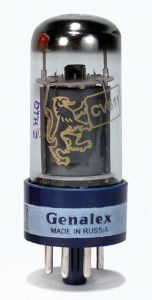
A few makers today produce amps that are very specifically intended to let you swap between output tube varieties for “tube tasting,” and models such as THD’s UniValve and BiValve, and Victoria’s Regal II and Two Stroke can take any of the common 8-pin types without need of re-biasing or other adjustment, as can the octal socket in Carr’s Telstar, which also uses an EL84 that cannot be swapped for a different type. For the most part, though, a maker will design an amp with a very specific tube type in mind, and will work toward the performance and sonic characteristics of that tube. Let’s explore the signature tones and capabilities of some of these more common output tube types.
6L6GC If you’re searching for an easy sonic reference of the 6L6GC in your mind’s ear, conjure up a classic aural image of “big Fender amp tone” and you’re there.This is the big-amp output tube traditionally seen in American-made amplifiers of more than 25 watts, and it has a bold, solid voice with firm lows and prominent highs. The sound can almost be strident in loud, clean amps that were designed for maximum headroom, or silkier and more rounded in softer designs like many of the tweed-style amps.
A pair of these will generate around 40 to 50 watts in an efficient class AB amp, and a quartet can put out up to 100 watts. In less-efficient cathode-biased designs (so-called Class-A amps) like TopHat’s Super Deluxe or Carr’s Rambler or a mid-’50s tweed Fender 5E5 Pro, a pair of 6L6s will put out around 25 to 35 watts.
This is the tube of anything from the Fender tweed Bassman, Pro, and Super; black-panel Twin Reverb and Super Reverb; and early Marshall JTM45 heads and Bluesbreaker combos (often as the 5881 variant, though many also used KT66s). 6L6s also featured in the Mesa/Boogie Mark One and several later amps in the series, many powerful Soldano and Bogner amps, and others. Big Dumbles like the Overdrive Special also favored 6L6s (and the similar 5881). Look in the back of many of the larger fun and funky American “catalog” amps of the ’60s and you’ll also find 6L6s, which fueled both the Silvertone 1484 head and the like, and Supro’s Thunderbolt combo.
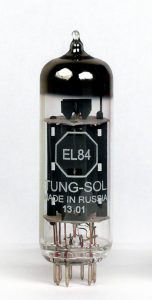
EL34 Float your aural imagination across the Atlantic, conjure up that big, British crunch tone, and you’re hearing the mighty EL34. This is the classic Marshall tube and the big boy of British amplification from the late 1960s onward. It can be driven at higher voltages to produce a little more output than the 6L6GC, and it sounds somewhat different, too, characterized by a fat and juicy but softer low end, sizzling highs, and a thick midrange that exhibits a classic crispy-crunchy tone when pushed into distortion. Configure it a little differently—say in a Hiwatt DR103—and the EL34 can also deliver the relatively tighter and bone-crunchingly punchy sounds that have rocked arena stages for decades
This is the tube of post-1967 Marshalls like the JMP50 “plexi” and “metal” panel amps, the Master Model 2203 and 2204 and JCM800, and the majority of modern models. It also appears in the classic Hiwatt models and was featured in the big amps of Orange, Vox, and Sound City, as well as several from Selmer, Traynor, and others.
Naturally, when a contemporary maker looks to recreate that Brit-stack kerrang! at full volume, they usually turn to EL34s. Plenty of modern makers also use this big tube in more original designs. Rivera and VHT have used EL34s for high-gain amp designs, and many Mesa models have employed it, while the Matchless Clubman, TopHat Emplexador, and several Friedman models all do their thing courtesy of this Brit-flavored tube.
6V6GT Think cranked-up studio or club amp on the left side of the pond and you’re hearing the 6V6GT. Smaller American-made amps of the 1950s, ’60s, and ’70s most often carried 6V6 tubes, which are known for their juicy, well-rounded tone and smooth, rich distortion, occasionally tinted with an element of grittiness that is not necessarily unappealing. They produce about half the output of their big brother, the 6L6, and are therefore more easily driven into clipping. A pair of 6V6GTs will generate a maximum of about 22 watts in a fixed-bias circuit, and around 15 to 18 watts in a cathode-biased circuit (think Deluxe Reverb and 5E3 tweed Deluxe, respectively).

The 6V6 was used in many Fender designs—four decades of the Champ, Princeton, and Deluxe lines among them—some great vintage Gibson amps like the GA-40 Les Paul Amp of the 1950s and early ’60s, and countless others. From the late 1980s to late 1990s reliable contemporary 6V6s were hard to come by, so few manufacturers designed new amps around this tube. This is what led Fender to seemingly uncharacteristically produce amps that used EL84s, such as the Blues Junior. This was rectified by the release of a rugged and reliable 6V6 from Electro-Harmonix, first, then contemporary makers like JJ and others, leading to a renewed popularity for this tube. Today, it proliferates again in the 20-watt-and-under range… alongside the next of our most popular sub-20-watt tubes.
In addition to the American classics and several reissues, 6V6GTs are used in many high-end amps from modern makers, such as the Carr Mercury V and Skylark, Tone King Imperial, Divided by 13 CJ11, Bogner Goldfinger, Dr Z Z-28, and scads of others. Some makers—as perhaps first and most tonefully done in Jim Kelly’s FACS model—use four 6V6GTs to generate from 30 to 45 watts.
EL84 This one is sometimes described as the “baby EL34” because of its classic British origins, but the EL84 really has a tone all its own. This tall, narrow, 9-pin output tube is best known for its use in classic Vox amps such as the AC15 and AC30, and is most often used today in nominally Class-A circuits that follow those templates. Classic sonic characteristics of the EL84 include sweet, bright, sparkly cleans and juicy, rich, harmonically saturated overdrive. Think jangle and chime with the volume reined in; shimmer, bloom, and sting when pushed a little harder. Much like the 6V6GT, a pair of EL84s will generate 15 to 18 watts, while four can deliver upward of 30 to 36 watts.
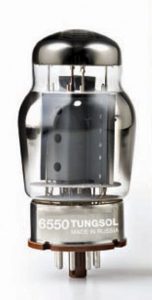
The EL84 can still exhibit a pretty firm, chunky low end in the right amp, but is best known for its detailed highs and a midrange that is crunchy and aggressive when pushed. Although we think of it as a classically British-voiced tube, many EL84-loaded amps make great partners with a Telecaster when pushed just to the edge of breakup for a harmonically resplendent flavor of biting twang.
In addition to the many classic Vox amps and smaller 18- and 20-watt Marshalls that used it, the EL84 also put the sting into the Watkins/WEM Dominator and other B-list British beauties. It got a surprising amount of use now and then from Gibson and other American makers of the late ’50s and early ’60s, was briefly used in the very first Tolex-covered piggyback rendition of the Fender Tremolux, and also stood in for 6V6s in Fender’s reintroduced club amps of the ’90s. In today’s boutique world, it’s one of the most popular tubes in use, featuring heavily in amps made by Dr Z, Matchless, 65amps, Komet, Divided by 13, TopHat, and too many others to mention.
KT66 This big Coke bottle-shaped tube was often considered a more robust stand-in for the American 6L6/5881 types in British amps of the early to mid ’60s. The declining availability of great examples meant that it was rarely used in new amps in the couple of decades following that, but it has made a comeback with appreciative boutique amp designers in particular in the 21st century. In some circuits it’s a little bolder, firmer, and fatter sounding than its more common American cousin, with substantial low end and a slightly more aggressive sound when pushed hard. It also has greater maximum volume capabilities. (While it might be a direct substitute for a 6L6GC in some amps, that isn’t always the case, so check with the manufacturer before making any changes.)
Originally best known for its use in some of Marshall’s original JTM45s, in the modern era the KT66 has of course featured in lots of JTM45-derived designs, but also in more original creations like the Dr Z Route 66, the original single-ended Carr Mercury, and a few others.

6550 The 6550 is most prominently known for its use in Marshall amps exported to the USA from around the mid ’70s to the mid ’80s, which used 6550 output tubes instead of the EL34s for reasons of availability and/or reliability. The change altered their character somewhat, as the 6550 doesn’t sound especially like an EL34, but more like a bigger, louder 6L6GC (in approximate terms). That’s not to say it’s a bad thing, just different, and many other makers have designed amps around this lesser-seen output tube, such as Alessandro and Engl. The 6550 is perhaps more commonly seen as an output tube in big bass amps, and was used for a time in Ampeg’s SVT, and has more recently appeared in models by Traynor and others.
KT88 This massive output tube was used in mega-powered classics like the 200-watt Marshall Major, where four big bottles generated about twice the wattage as the same number of EL34s in a 100-watt Super Lead. Appearing like a larger KT66 in a fat, Coke bottle-shaped glass envelope, the KT88 is capable of operating on extremely high voltages and producing a lot of wattage as a result, with a big, bold, firm sound to go with all that power.
That being said, several modern amp designers have discovered they can also coax a lot of sweetness out of this tube by pushing it a little more gently and putting the right preamp in front of it. Divided by 13’s RSA 23 uses a pair of them, as do the Fryette Sig-X, the Bogner Shiva 20th Anniversary, and defunct RedPlate Astroverb and Carol-Ann Tucana.
Whether you’re selecting an appropriate tube amp or dialing in an amp model, understanding the basic characteristics of these output tubes can help you nail down your desired tone, and set the foundation for creative and expressive playing. You can certainly work against type when necessary—making just about any kind of music with any kind of amplifier—but working with these tubes’ strengths almost always makes the journey easier, and the results more authentic.

Dave Hunter is the author of The Guitar Amp Handbook, British Amp Invasion, The Gibson Les Paul, Fender 75 Years, and several other books, and is a regular contributor to Guitar Player, Vintage Guitar, and The Guitar Magazine (UK).
Individual tube photos courtesy of New Sensor Corp/Electro-Harmonix.
Related posts
Leave a Reply
You must be logged in to post a comment.
By submitting your details you are giving Yamaha Guitar Group informed consent to send you a video series on the Line 6 HX Stomp. We will only send you relevant information. We will never sell your information to any third parties. You can, of course, unsubscribe at any time. View our full privacy policy


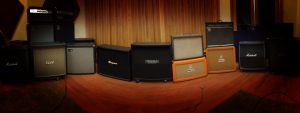
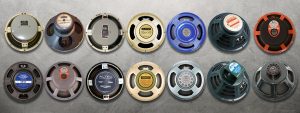

This is a great reference! Thank you Dave Hunter for putting this together…
Don’t let Glenn Fricker read this article, he would be upset…
I had a Sound City head and cab over 40 years ago. I loved it, way better than a Marshall. But being a keyboard player I part-ex’ed it for a keyboard (don’t ask me what).
However, from the late 80’s I started playing a bit of rhythm guitar in every band I’ve been in and have done ever since. I wish I’d never sold the Sound City! Eventually I settled on the HD500, but I keep looking out for a old Sound city….
The PRS Sonzera 50 also uses EL34s. It’s a combo, but sounds as sweet as a Marshall stack.